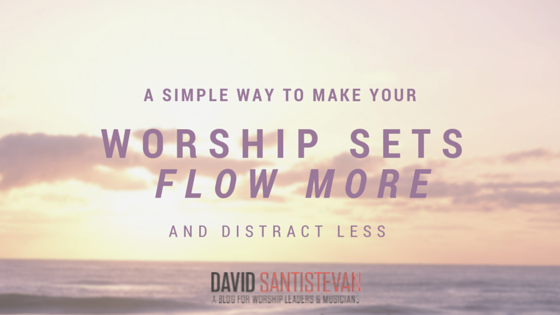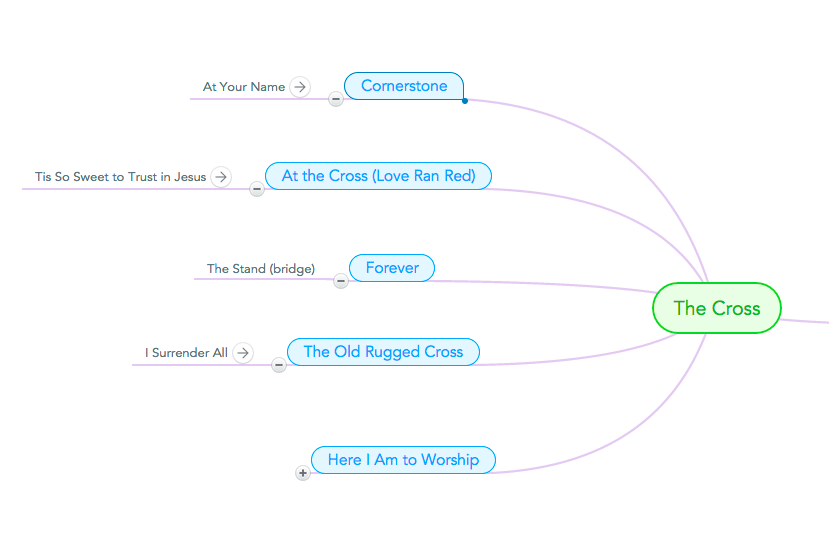
Leading Worship is about connecting human hearts to something greater.
It’s about shining a spotlight on the glory of God and getting out of the way. It’s about drawing attention to something outside of yourself. But isn’t it true how often our worship sets do anything but that.
- We lead for a room of spectators.
- Our songs don’t connect.
- The band is more into their instrument than worship.
- It feels like we’re just playing a bunch of songs for people.
The starting place for creating worship sets that flow isn’t with practical tips. It doesn’t start with the latest, greatest method.
It starts with a leader’s burning heart for Jesus and a compassionate heart for people.
First Things First
If I’m honest, oftentimes I’m the distraction. We’re the distraction, worship leaders. We need to strike a balance – not being so innovative that we steal attention and not being so sloppy that we steal attention. Let’s not forget our role as worship leaders.
It’s not about a larger platform and a brighter spotlight. Worship leading is about becoming less. It’s pastoral. It’s serving. It’s getting in the trenches. It’s about kneeling down, with tears in your eyes, compassion in your heart, taking people by the hand and leading them to the open arms of Jesus.
Channel the energy that you would normally use to love your ego and love God’s people.
Your worship set won’t flow if you don’t love His presence and love His people.
Are we on the same page?
Great. Because I want to leave you with something super practical as well.
Lose the Distraction
I think we would all agree that our worship sets should sound more natural and connected. Less like a concert of song to song to song and more of a journey. I talked briefly about this in episode 11 of the Beyond Sunday podcast, but I wanted to take it a little deeper and make it more practical.
There’s nothing wrong with prearranged songs. There’s nothing wrong with producing entire songs. That has its place. But I really believe that every worship set should have at least one moment where everyone comes up for air – no pulsing music, no organized song, no rushing.
And then – creating a medley of a few songs that go together. Why? Because medleys create space for momentum to happen. Rather than starting and stopping songs with full arrangements, we’re going on a seamless journey that allows people to worship with abandon.
We’re drawing attention away from the slickness of our arrangements to the truth of who God is. And that lights peoples hearts on fire.
So as it relates to medleys, here are a practical tips that I have found helpful:
Create a Mind Map
Ever created a mind map before? I know it sounds kind of new-agey and scary. It’s anything but.
You can use a piece of paper, a white board, or even an iPad app like MindMeister like the screen shot below. The goal here is to write a theme in the middle of the page and see what songs come to mind from that theme. Draw a line and add that song.
Keep doing that until you run out of ideas. Then take it levels deep. What songs come to mind after that second tier of songs? Connect those as well. After a while, you will have dozens and dozens of songs as options for your flow moments.

What’s so cool about this is that you may have started with a theme like “The Cross” and ended up with a theme like “Trust”. That’s great because we want to take people on a journey.
What we don’t want is to just throw songs together because they are popular. Rather, think strategically and theologically – what will make sense in people’s minds? How can you position the truth so it lands strong upon people’s hearts?
A Few More Thoughts
Find logical song connections – Oftentimes I’ll think, “After I sing the last phrase of this particular song, what song naturally comes to mind?” Sometimes the closing phrase of one song is the opening phrase of another, as in the case of Cornerstone’s final line “He is Lord, Lord of all” and At Your Name’s opening line “Lord of All the Earth we shout Your Name.”
Combine new and old – When you’re thinking of songs to add to your medley, don’t just think new and hot, top CCLI charts. Think about how you can dip into the past and do some hymns or older songs that you know your congregation loves. The goal isn’t to be cool, trendy, and innovative. The goal is to connect with the room.
Combine time signatures – Thinking in time signatures also helps. If I’m in 6/8 time, it’s helpful to find other songs that are also in 6/8 time to continue the momentum. For example: How He Loves, Good Good Father, Your Great Love, and Great Are You Lord.
Keep Consistent Keys – Also, don’t box your songs into any particular key. When you’re in a medley moment like this, it’s best to keep them in the same key for flow purposes. Any song can be done in any key. It’s actually very cool to take a song that’s usually very high and sing it lower in a more tender way.
Let’s wrap up. Remember, there’s nothing wrong with doing full arrangements of songs. But find one spot within your worship set where you can pause, breathe, and then go on a medley journey. It makes the experience feel less plastic and rehearsed. It gives people space to really engage.
How about you? Do you create medleys like this?
Do you have moments in your worship set where you flow?
Let’s talk in the comments. It’s better that way. You can leave a comment by clicking here.
[ois skin=”Beyond Sunday 2″]
David, this is great! Yes – make space, yes – chorus medleys. I really like your mind map process. I love mind maps but had not used one in this application before. Awesome post bro!
I really just started doing this more often, Rob. I used to just do it all in my head but mapping it out allows me to see tons of possibilities.
Great wisdom in your words of experience, David! I’m finding the more I peel back the layers of “stuff” and get to the core of my purpose, the more our congregation responds and feels welcomed to worship along with us. They sang so loudly this Sunday, I chuckled inside and my on-going goal is to have as many of those moments as possible. Our congregations want to feel secure and confident in worship, but perhaps the pursuit of the professional has inadvertently created an intimidating atmosphere for the average church goer. Time to climb out of the ditch and remind ourselves that we have a priestly role as worship leaders. Our goal is simple: connect people with the Lord.
Yes! That’s the tension – knowing when to add “stuff” and knowing when to peel back. Some churches could stand to add a little creativity to their worship. Others may need to dial it back. Well said!
Good stuff, David! Thanks for sharing this.
I especially like the reminder about the breath of fresh air. Especially with the younger crowds that aren’t used to “enjoying” the silence, it’s been a bit tough, but I’m prayerfully working my way to getting them used to the diversity available in worship.
The mind map part is still a little abstract to me, but I’ll try to give it some more thought.
Keep up the good work!
Thanks Daniel. Silence is a lot less awkward when it is explained. And it has to be at the right moment.
Let me know how the mind mapping of songs goes!
Hi David… This blog has blessed me greatly. Thank you for sharing yhe deep, profound and helpful insights for leading in worship. This blog sounds more relationship & connectivity with God & His people than just mere methods or techniques. I thank & praise God for pouring His divine truths & revelations on u, which r blessing. I will share this with others. Blessings. Kiran, India
Wow, thank you Kiran! Really appreciate you stopping by and leaving a comment. Hope to see you back!
Hi David. I’m so glad I found this blog! The posts and podcasts have really ministered to me these last few months. Thank you!
While I’ve never actually done a written down Mind Map before, this is exactly the process I use (all in my head) when putting our song sets together. This wasn’t such a necessity when we were given 30-45 minutes for worship. Back then, we could play some fun, cool songs at the beginning, then ease our way into something more purposeful. But a few years ago, our pastor decided he wants only about 15-20 minutes of music, so now I have to make every second count. I’ve found that making sure the songs flow from one to the next can take the congregation deeper, faster.
Using a Mind Map will be a GREAT way to teach the leaders I’m training about my thought process and why I choose the songs that I do.
I’m glad you found it too, Anessa! Love the privilege of encouraging worship leaders. Where do you lead worship?
I lead at Gateway Believers Fellowship in Carnesville, GA. We’re in what we call “the buckle of the Bible belt” where the county has 22,000 people and about 250 churches. Most churches around here have about 25 members, so with an average of 100+ in attendance on Sundays, we’re practically a mega-church where our community is concerned 🙂
We’re non-denominational, inter-racial, and cross-generational. (That sentence made my inner grammar nerd all happy.) And our music is as diverse as our congregation. We do modern worship choruses, old timey hymns, gospel r&b, you name it and we’ve probably done it (or at least attempted it!) and we write our own songs too.
David,
This is very helpful. This is something I have been looking into trying within our worship sets and you have helped give me more flexibility in successfully accomplishing this. I want the sets to be engaging and put all the focus on Jesus, not the musicians or the arrangements. Thank you!
I’m super excited to try this app!!!! I guess I’ve been doing something like this for a while, but it will be cool to see it this way. Thank you.
By the way…this is also kind of a way to start writing a song….write a theme in a bubble and then brainstorm around it. Someone showed that to me in a songwriting class, and I tend to use it when I’m writing and get stuck – its helped me a few times.